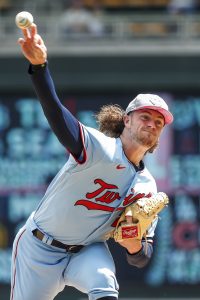With the postseason looming, our prospect attention shifts out west where the Arizona Fall League is set to begin this evening. The rosters include several notable prospects. They’re joined by the usual smattering untouted, statistically effective players. Today, let’s skip the big names and focus on the guys fighting for recognition. Those with long memories will recall Edouard Julien’s emphatic AFL performance. “Big Hype” can be built in Arizona.
First, let’s back up and think about Julien’s platform last season. He played well at Double-A as a 23-year-old. In the past, that was on the old side of age-appropriate. Now, it’s just flat-out old for the level. A 23-year-old either dominates Double-A or isn’t considered a prospect (there are exceptions). He was arguably the top player in the AFL last season (Heston Kjerstad won the MVP). Julien went on to post a 2.8 WAR debut in the Majors over 408 plate appearances. High BABIPs are a key component of his success.
Notably, defense was and remains a concern with Julien. There are always a few players who slide under the radar because they have a good-not-great bat married to defensive concerns.
Five Big Hype Prospects
Damiano Palmegiani, 23, 3B, TOR (AAA)
(AA/AAA) 557 PA, 23 HR, 7 SB, .255/.364/.478
There’s some surface commonality between Palmegiani and Julien. They’re both disciplined hitters who produced big league-caliber exit velocities. Scouting reports go out of their way to question the defensive aspects of Palmegiani’s game. He mostly played first base at Triple-A after spending most of the season as the starting Double-A third baseman. Palmegiani also has a shaky hit tool. When he connects, it tends to be well-struck. However, between the discipline and a moderate swinging strike rate, there’s a chance nearly half his plate appearances will end without a batted ball. Barring a profile change, he’ll need high BABIPs just like Julien. Palmegiani is not Rule 5 eligible this winter.
Carter Baumler, 21, P, BAL (A)
(CPX/A) 17 IP, 11.12 K/9, 4.76 BB/9, 3.18 ERA
While we don’t usually watch the AFL for pitchers, Baumler is an exception. A fifth-round pick in the abbreviated 2020 draft, Baumler’s career has been waylaid by injuries, mostly to his shoulder. He managed to return to the mound in late July and even faced 16 batters in his final regular season outing on September 7. He was once viewed as a future Top 100 prospect candidate. With health, he’s young enough to get back on track. He features a well-designed fastball-curve combo. He also shows a slider and changeup, both of which are in want of further development. Baumler is not Rule 5 eligible this winter.
Brainer Bonaci, 20, 2B/SS, BOS (AA)
(A+/AA) 350 PA, 11 HR, 7 SB, .297/.354/.464
Bonaci is on the Ramon Urias utility track. He’s Rule 5 eligible this winter. I figure there aren’t many scenarios in which he’s left off the Red Sox roster. Bonaci is a well-regarded fielder, but he’s slow-footed. He’s likely limited to second and third base down the line. His bat is trending in a league-average direction. Given he’s a switch-hitter, the total sum is a useful player who fits well on any roster.
Zach Dezenzo, 23, 3B, HOU (AA)
(A+/AA) 410 PA, 18 HR, 22 SB, .304/.383/.531
Early in the season, Dezenzo was among the top minor league performers by wRC+. After beating up on High-A pitchers, he performed merely decently against Double-A arms. Even so, at least one source of mine believes Dezenzo is Top 100 prospect material. Another source says he has a hole in his swing. While there’s no question about the quality of his contact, the frequency of his contact could leave him in the Quad-A bubble. He’s likely in the AFL to work on defense. He is not Rule 5 eligible.
Jakob Marsee, 22, OF, SD (AA)
(A+/AA) 568 PA, 16 HR, 46 SB, .274/.413/.428
Marsee reminds me of a lower-impact version of Julien, one whose future big league role will depend upon making good on the few opportunities he’s given. That he’ll receive such opportunities is of little doubt. He’s a disciplined hitter with a high rate of contact. As a lefty, he’s also on the strong side of any platoon considerations. Defensively, he’s considered fringy as a center fielder. He doesn’t have quite enough pop to excite evaluators about a corner outfield role. Still, he profiles as somebody who could post offensive numbers not unlike Julien’s debut. That’s a Major Leaguer, even if we’re only talking about a platoon bat on the Athletics. He’s likely in the AFL to generate trade interest. He is not Rule 5 eligible.
Three More
Hao-Yu Lee, DET (20): You might recognize Lee from this past trade deadline when he was dealt from Philly to Detroit for Michael Lorenzen. A quad strain limited him to 32 post-trade plate appearances. Lee will be looking to make a strong impression on his new employers. He is not Rule 5 eligible.
Kala’i Rosario, MIN (21): Rosario is one of the most accomplished power hitters in the AFL this season. He’s coming off a 21-homer campaign in High-A built around hard contact and plenty of pulled fly balls. He cut down on his swing-and-miss this year by being more patient. He is not Rule 5 eligible.
Abimelec Ortiz, TEX (21): Ortiz should be the odds-on favorite to lead the AFL in homers. He delivered 33 dingers this season split between Low- and High-A. With a strong AFL, he’s a fringe Top 100 prospect candidate. He’s also not Rule 5 eligible.
Did I miss a detail or nuance? DM me on Twitter @BaseballATeam to suggest corrections.

